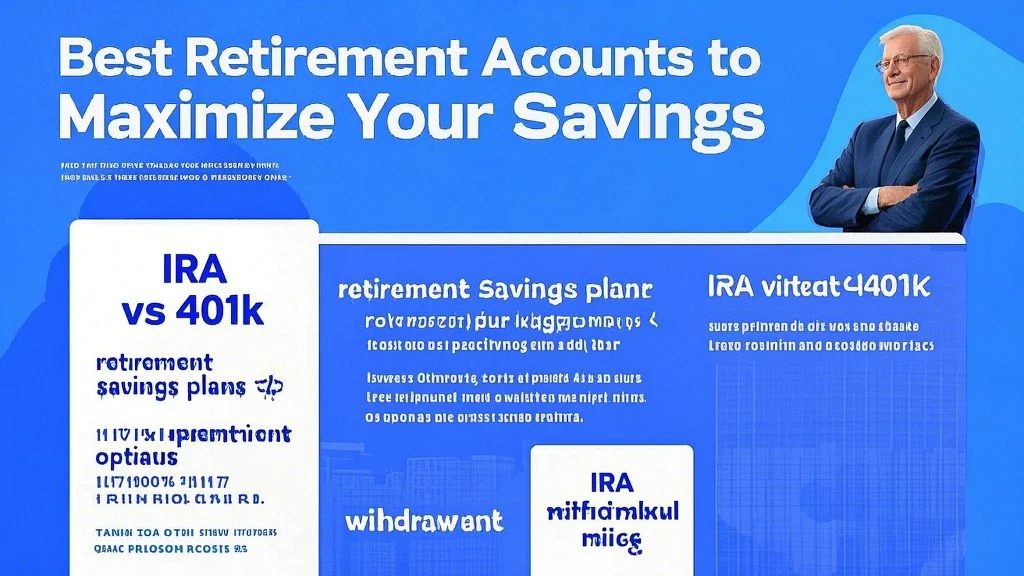Exploring the Best Retirement Accounts for Your Future
When it comes to securing your financial future, understanding the best retirement accounts available is crucial. The right account can make a significant difference in how much you’re able to save and how quickly your nest egg grows. From traditional options like 401(k)s and IRAs to more specialized accounts, each offers unique benefits that can help you maximize your retirement savings.
One of the key factors to consider when choosing a retirement account is the tax advantages it offers. Some accounts provide tax-deferred growth, allowing your investments to compound without the drag of annual taxes. Others offer tax-free withdrawals in retirement, which can be particularly valuable if you expect to be in a higher tax bracket later in life. Understanding these differences is essential for making informed decisions about where to put your retirement savings.
Comparing IRA vs 401(k) Options
The debate between IRA vs 401k is a common one among retirement savers. Both accounts offer valuable tax advantages, but they differ in important ways. 401(k) plans, typically offered through employers, often come with the added benefit of employer matching contributions, which can significantly boost your savings. These plans also allow for higher annual contribution limits compared to IRAs.
On the other hand, IRAs offer more investment flexibility and control. With an IRA, you can choose from a wider range of investment options, allowing you to tailor your portfolio to your specific needs and risk tolerance. Additionally, IRAs can be opened by anyone with earned income, regardless of whether they have access to an employer-sponsored plan. Understanding the strengths and limitations of each account type can help you make the most of your retirement savings strategy.

Maximizing Your Retirement Savings Plans
Effective utilization of retirement savings plans requires a strategic approach. One key strategy is to take full advantage of employer matching contributions in 401(k) plans. This essentially represents free money that can significantly accelerate your retirement savings growth. Another important consideration is the timing of your contributions, as making them early in the year allows more time for your investments to grow.
For those looking to maximize their savings, considering multiple retirement accounts can be beneficial. This might involve contributing to both a 401(k) and an IRA, or exploring other options like Health Savings Accounts (HSAs) or self-employed retirement plans if applicable. Diversifying your retirement savings across different account types can provide both tax advantages and financial flexibility in retirement.
Exploring Diverse Retirement Investment Options
Within your chosen retirement investment options, it’s crucial to maintain a diversified portfolio that aligns with your risk tolerance and time horizon. This typically involves a mix of stocks, bonds, and other assets that can provide both growth potential and stability. As you approach retirement, your asset allocation should gradually shift to become more conservative, protecting your accumulated savings.
Target-date funds have become increasingly popular in retirement accounts, offering a hands-off approach to asset allocation. These funds automatically adjust their investment mix as you approach your target retirement date. However, more experienced investors might prefer to manage their own asset allocation, potentially achieving better returns through active management and strategic rebalancing.
Understanding IRA Withdrawal Rules and Strategies
Navigating IRA withdrawal rules is crucial for maximizing the value of your retirement savings. Traditional IRAs have specific rules regarding required minimum distributions (RMDs) that begin at age 73, while Roth IRAs offer more flexibility with withdrawals. Understanding these rules can help you avoid costly penalties and optimize your retirement income strategy.
One effective strategy is to carefully plan your withdrawals to minimize taxes in retirement. This might involve coordinating withdrawals from different account types or considering Roth conversions during lower-income years. Additionally, understanding the exceptions to early withdrawal penalties can provide valuable flexibility in case of unexpected financial needs.
Building a Comprehensive Retirement Savings Strategy
Creating a robust retirement savings strategy requires careful consideration of your entire financial picture. This includes not only choosing the right accounts and investments but also planning for potential healthcare costs, long-term care needs, and other retirement expenses. Regular reviews of your strategy, especially as you approach retirement age, can help ensure you’re on track to meet your financial goals.
Remember that retirement planning is an ongoing process that should evolve with your changing needs and circumstances. By staying informed about changes in tax laws, investment options, and economic conditions, you can make timely adjustments to your strategy. Working with qualified financial professionals can also provide valuable guidance and help you navigate complex financial decisions as you prepare for a secure and comfortable retirement.
